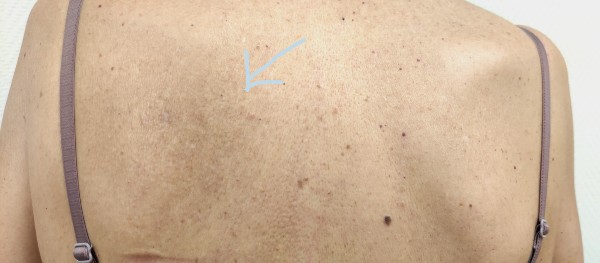You may have an itchy spot on your back. If you have had it for some time and it is near the scapula or shoulder blade, you probably have notalgia paresthetica.
What is notalgia paresthetica?
This is a very specific condition consisting of unilateral itching of the back. It is typical that this itching is located at the level of the shoulder blade.
It is usually continuous and can become quite annoying, causing the sufferer to scratch constantly.

This prolonged scratching often results in marks on the skin, with scratches and, in the long run, a brown spot right in the itchy area. Microscopically, a material called amyloid can be seen accumulating under the skin (this is why we technically call the spot “macular amyloidosis”). It is therefore important to insist that the spot is not the cause of the itching, but the result.
In this link you can see more images of notalgia paresthetica.
Why does the spot on my back itch?
It is believed that the fact that the skin itches specifically at this anatomical point is caused by a small entrapment of nerve roots at the level of the T2-T6 vertebrae, which would cause a sensation of increased sensitivity in this particular area.
How is notalgia paresthetica diagnosed?
If you consult a specialist (either online or in person) for this reason, he/she will probably be able to diagnose this entity simply with a clinical examination. Usually, it is not necessary to perform any additional tests or skin biopsy because the clinical characteristics are very specific and allow to distinguish this condition from other types of spots on the back.
In some cases, when the itching significantly affects the quality of life, it is possible to extend the examination by consulting a traumatologist or neurologist. In this way, the cervical or muscular cause of the “pinching” that causes the itching can be identified.
How is the itchy area on my back treated?
The best treatment for notalgia paresthetica is not clear. Nor is it usually fully effective.
Moisturizing and refreshing creams (such as aloe vera) or more specific creams containing soothing or numbing agents (such as capsaicin or lidocaine) can usually be used.
If these are not sufficient, we sometimes have to resort to oral medications such as gabapentin or amitriptyline.
Some authors also describe that botulinum toxin can be effective, although their results are not completely conclusive. Physiotherapy or the use of TENS (transcutaneous electrical nerve stimulation) may also be useful.
How does notalgia paresthetica develop?
Unfortunately, it is a condition that is rarely cured; it tends to become chronic over time. In this sense, it is important to understand that it is not related to any internal disease and does not pose a major health risk.
Do you suffer from notalgia paresthetica?
